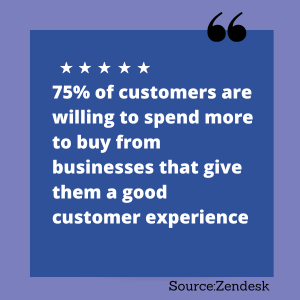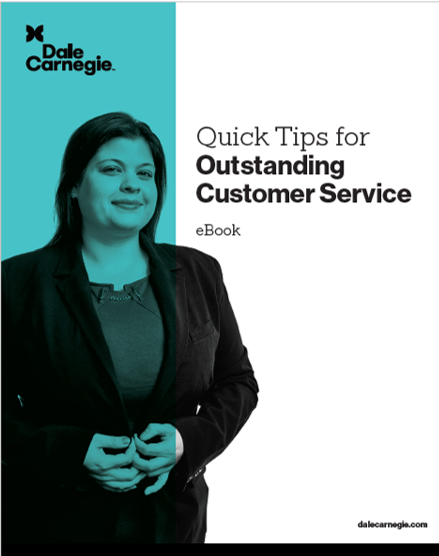 To create a culture that can deliver outstanding customer experience, we must first identify exactly what constitutes an ‘outstanding customer experiences’ and this will vary from industry to industry, offering to offering, and customer to customer. In a marketplace that affords customers multiple forums to rate and review businesses, building this into our culture is something brands must strive for. We can start by looking at our own experience with brands and consider how our values and principles can be built into a customer charter that can inform outstanding customer experience.
To create a culture that can deliver outstanding customer experience, we must first identify exactly what constitutes an ‘outstanding customer experiences’ and this will vary from industry to industry, offering to offering, and customer to customer. In a marketplace that affords customers multiple forums to rate and review businesses, building this into our culture is something brands must strive for. We can start by looking at our own experience with brands and consider how our values and principles can be built into a customer charter that can inform outstanding customer experience.
What are ‘outstanding customer experiences’?
Outstanding service is distinct in that it exceeds customers’ expectations. It can be helpful to think of customer experience on 3 levels, poor, good and outstanding. To drill into this further, a LinkedIn webinar provides a good analogy for this by defining good service as walking into a room, flicking the light switch and the lights coming on. It is what you wanted and expected to happen, but it won’t stay in the memory. Walking into that room and the lights not coming on is a poor experience; its not what we expected and will leave an imprint. In this analogy, outstanding customer experience might be flicking the switch and being greeted by name from an auto-voice as the lights come on. It is therefore delivering a level of service that is expected, such as friendliness, but also going above and beyond what was anticipated – to surprise and delight.
Brands must also recognise that every customer is different and what they perceive as an outstanding customer experience will vary. This tends to come to light when service has fallen short in some way and the same resolution is offered to customers; some will perceive this as adequate, but others will feel the attempt to rectify the situation is just not good enough.
Outstanding customer service can therefore be seen as when you have not just met their expectations, but you have exceeded them, leaving an indelible impression.
The benefits of outstanding customer experience are impossible to ignore:

The benefits of outstanding customer experience are impossible to ignore:
- Customer satisfaction and retention
- Staff satisfaction and retention
- Trust and loyalty
- Improved innovation
- Increased sales
- Higher profits
By striving for outstanding customer experience, you can create brand ambassadors who will market your business for you as they tell friends and family about the exceptional experience they had. It’s not just marketing; statistics show customers are prepared to pay more for a great customer experience. A caution however, the same goes for negative experiences too; people will warn others off a brand so you simply can’t afford to deliver anything less than exceptional.
Start by getting fanatical about the engagement of both your customers and team. To effectively engage your employees, they need training and career development, praise, and the chance to participate in corporate change. To engage your customers, they must feel exceptionally valued and important at every interaction and in every communication with your business.
Brands that deliver outstanding customer experience.
Netflix has exploded in subscribers because it is simple to use and creates an exceptionally personalised experience. Not only can you create multiple profiles to tailor the viewing experience in your house, but it also remembers the shows you like and will offer up similar viewing because it learns through your use and ratings of shows. The result is an exceptionally intelligent viewing experience, uninterrupted by ads at an affordable monthly price point that rivals Sky and Virgin.
Another example of a superb customer experience is Uber. The biggest frustration most taxi passengers used to experience was having no idea when their ride would arrive. The in-app tracking of your taxi with precise driver and car details eliminated waiting out in the cold, scanning the streets. It removed a huge element of risk and replaced with a robust sense of security. The linking of your card to the app also meant an end to worrying about holding onto cash, and the rating sections further empowered both driver and passenger.
So how can smaller brands and business attempt to emanate the care and attention to detail the bigger brands have? Simply ensure you engage with your customers to assess their expectations, find out what they want beyond what you do, and ensure that every single touchpoint you have with your customers ensures they go away with a memorable experience that leaves them feeling valued and special.
The Dale Carnegie Customer Experience
We constantly measure client experience, training effectiveness and customer recommendations, and our VOC and NPS scores reflect the world-class level of service we have become renowned for. Our client satisfaction scores are on par with or exceed well-known brands such as Apple, Amazon and Disney.

As a relationship focused company, we put people at the centre of our brand experience. Those people are not only our clients but our colleagues too, because without their buy-in and understanding we cannot provide the experience and service that makes us stand-out.
Our customer philosophy has been defined Dale Carnegie’s core principles for building strong relationships. These principles include:
Showing genuine interest in others
A customer-first approach goes beyond being friendly. It is individual and focussed.
Smiling
This principle works even over the phone, as people can hear it in your voice. It just happens to be exceptionally more powerful face to face. Smiling conveys you are genuinely happy to see the other person and be of assistance to them.
Remembering names
This is a quick way to establish rapport, build trust and deepen the relationship. When you use a customer’s name they know you are completely focused on them.
Being a good listener
When we engage well with a customer, we hear their individual needs and then exceed their expectations by going over and above their needs.
Being sincere
Authenticity and sincerity are key ingredients to delivering outstanding customer experience. Customers can detect scripted responses making them feel unappreciated and undervalued.
Avoiding arguments
“The customer is always right” became the core mantra for service-based businesses because it avoids conflict and views every situation as a chance to put the customer first.
If you are wrong, admit it quickly and emphatically
Fact – We all make mistakes. It’s how we handle them that shows the calibre of our leadership and the nature of our organisation. So if you make a mistake – admit it, apologise, explain how you’re going to fix it and how you’ll ensure it doesn’t happen again… and then move on.
Show respect for the other person’s opinion. Never say, ‘you’re wrong’.
Even if they are, drawing attention to someone else’s mistakes is not the way to forge a trusting relationship, instead you can call attention to their error or misunderstanding indirectly. Use language that shows empathy and is not accusatory.
Try honestly to see things from the other person’s point of view
We all have different expectations and if our customers don’t feel listened to, not only does it make it difficult to come to a resolution in that instance, but they will also take their business elsewhere.
Create a Customer Charter
A customer charter is a written document that is essentially a promise or public declaration of what you strive to do for your customers. It will reflect your commitment to serving your customers and provides staff with a clear message on what is expected. Using this document both internally for your team and externally for your customers keeps the business accountable and aligned with its core values. What a customer charter does:
Ensures your brand values are living breathing principles.
When you create a charter it crystalises who you are as a brand and transmits that into a message that is accessible to your employees and customers.
Gives your staff transparency on your mission.
Leadership teams can often be guilty of not relaying the overall mission of the business to their staff. Putting it into a charter ensures your team have visibility on where you are headed.
Underpins the delivery of your product or service.
The values that are sewn into the charter are a reminder of what is the minimum expectation for how you service your customers.
Builds trust with your target audience.
If a business is prepared to outwardly declare its promise of service, then it projects confidence in its ability to honour this commitment.
Helps move customers from consideration to purchase.
Make sure the charter is visible at relevant points online and at appropriate touchpoints in-store to create a sense of safety and security in a customer’s decision-making process.
A customer charter is therefore a clear intention of what you expect from your representatives, and what customers can expect from your brand when they interact with you. As a team, you must decide on what the satisfactory bare minimum service levels are, and then inspire and motivate team members to go beyond that.
Creating a culture that delivers outstanding customer experience is built through understanding what constitutes outstanding service, and recognising that customers have unique expectations of your brand, and the role it fulfils for them. Continual engagement with both staff and customers ensures a customer focused culture that will grow and evolve. Make sure your brand’s core values and principles are woven into every single element of the customer journey, and create full accountability through a charter that transmits your commitment to outstanding customer experience.

